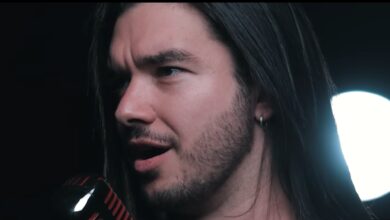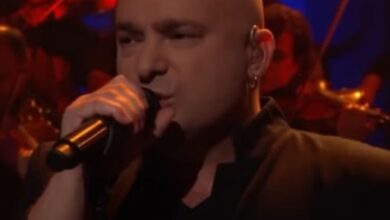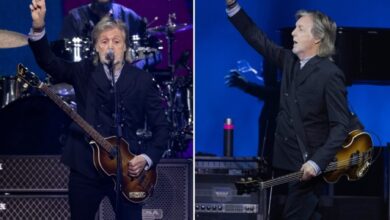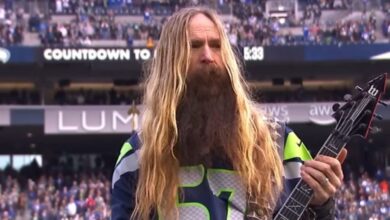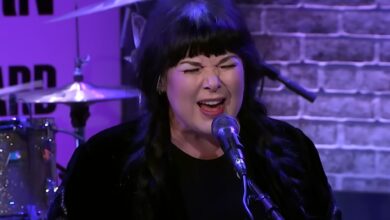Metallica Lit Up Levi’s Stadium with an Explosive “Battery” in Santa Clara 2025
During Metallica’s thunderous assault on “Battery” at Levi’s Stadium in Santa Clara on June 20, 2025, 60-year-old James Hetfield roared through the serrated opening riff as if the years had shaved nothing from his bite. Kirk Hammett’s whammy-bar shrieks collided with Lars Ulrich’s double-kick barrage, and the instant the song detonated, circle pits spiraled across the floor, proving once more why this 1986 classic still opens veins of pure adrenaline.
The band’s M72 in-the-round stage—set dead center on the 50-yard line—meant no fan was more than a few dozen meters from the musicians. Massive speaker towers ringed the platform, and eight fire cannons lined its perimeter, launching plumes with every down-stroke. Inside the stadium, the only thing anyone felt was thundering low-end and the heat of the flames.
Earlier in the set, Metallica had warmed up the audience with “Creeping Death” and “For Whom the Bell Tolls,” but “Battery” arrived like a stick of dynamite tossed into a smoldering campfire. Seeing it land midway through the evening—rather than the encore slot it once occupied—felt like a statement: the older they get, the less the band intends to pace itself.
As the song’s breakneck gallop kicked in, visible ripples of heat rose from the stage lights, and columns of flame shot five stories into the night. For a moment the pyrotechnics outshone the Bay Area’s starlit sky, yet nothing eclipsed the wall of voices screaming, “Battery is found in me.” The line echoed off concrete upper decks like an artillery round.
Fans near the barricade slammed shoulder-to-shoulder, some wearing faded Damaged Justice tour shirts, others in brand-new M72 merch. Up in the 300-level, thousands fist-pumped in time while smartphones captured the melee. Local news crews filming crowd shots later noted the roar peaked above 110 decibels—roughly the sound level of a jet on takeoff—during the final chorus.
Hetfield’s grin between verses was pure mischief; every time he let the audience handle a lyric, he stepped back and wagged his head like a proud coach watching the home team score. Though the song offers no true vocal rest, he still managed theatrical pauses—stabbing the air with his pick hand to cue each tempo change, then bursting back in with that trademark sandpaper bark.
Kirk Hammett’s solo—delivered on a green sparkle ESP loaded with wah fury—felt like a freight train leaving the rails. He bent each note until it squealed, then dove straight into harmonic flurries that brought memories of 1980s arenas flooding back. Despite decades of global stages, Hammett still peeked over his shoulder, as if chasing the breakneck riff rather than leading it.
Robert Trujillo stalked the catwalks in tight circles, spider-walking his fingers across the fretboard, long hair whipping like a windmill gone rogue. Each time he sidled up to Hetfield for a synchronized headbang, the crowd doubled its volume—a testament to how the bassist’s relentless energy has become the modern band’s secret weapon.
High above, Ulrich’s rotating kit turned slowly, giving every section of the stadium a front-row view as he hammered lightning-fast triplets on the bell of his ride. The drum riser’s motion matched bursts of flame that traced the stage’s circumference, a choreography equal parts spectacle and athletic feat that kept even jaded veterans wide-eyed.
For all its velocity, the performance still felt personal. Between verses, screens flashed black-and-white photos of the band’s 1986 tour, a subtle reminder of the wild ride from Bay Area clubs to NFL stadiums. Some fans lowered their phones, eyes misting over at the thought that three of the four men onstage had been hammering this tune for nearly forty years.
Off the field, longtime devotees swapped stories of early shows at the Stone and the Old Waldorf, marveling at how the same riff that once rattled tiny monitors now shook steel rafters. Many brought their kids—first-time concertgoers who learned “Battery” from video games and TikTok—and together they shouted every word, bridging generations through pure volume.
Local critics raved the next morning that no other act on the M72 bill matched the raw force poured into these five minutes of thrash fury. One columnist noted that Hetfield’s down-picking, still clocked at nearly 200 beats per minute, seemed to defy both age and conventional muscle endurance.
Fans flooded social media with clips of the breakdown, some slowed to half-speed to study Ulrich’s stick flips and Hammett’s finger placements. Within twelve hours, aggregate uploads had surpassed three million views, turning the Santa Clara “Battery” into the night’s runaway viral highlight.
Even so, the band treated it as just one chapter in a larger story. “Battery” flowed straight into “Master of Puppets,” keeping adrenal glands on overload. Hetfield later joked, “We figured you’d want two workouts back-to-back,” a quip that drew exhausted laughter as thousands caught their breath.
By the encore, when fireworks finally lit the sky, many still buzzed about the song’s sheer ferocity. If Metallica’s goal was to prove that raw speed and precision can age like fine bourbon, the Santa Clara rendition of “Battery” served as the clinching exhibit—thrilling, punishing, and somehow still gaining bite with every passing year.
Leaving Levi’s Stadium, drenched in sweat and echoing riffs, fans agreed they’d witnessed a definitive statement: whatever the calendar says, the Bay Area legends remain masters of thrash velocity. And as “Battery” fades from ringing ears into muscle memory, one truth lingers—there’s no substitute for the feeling when forty years of history detonates in real time.
Related videos :

